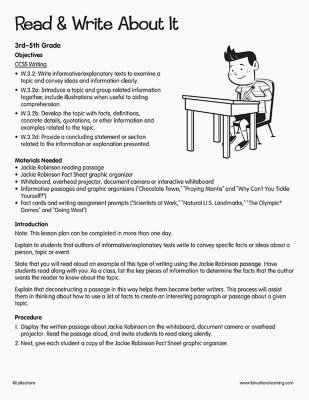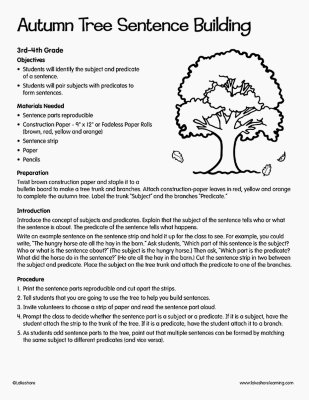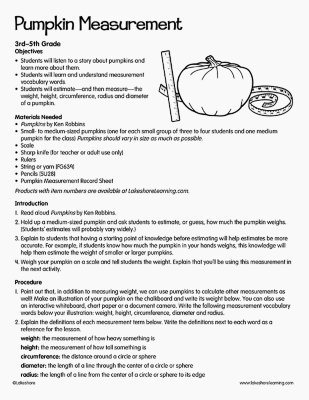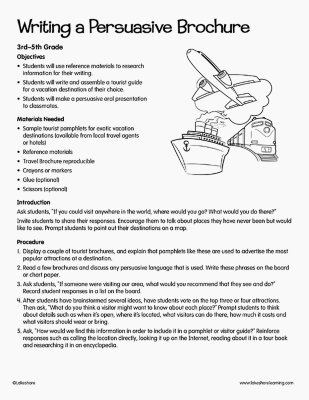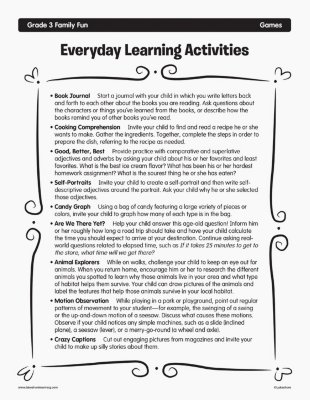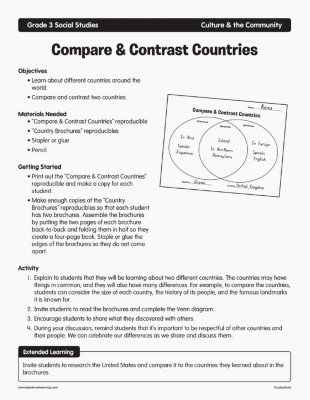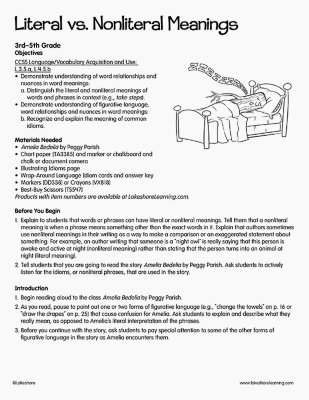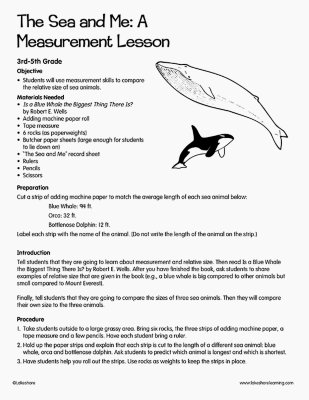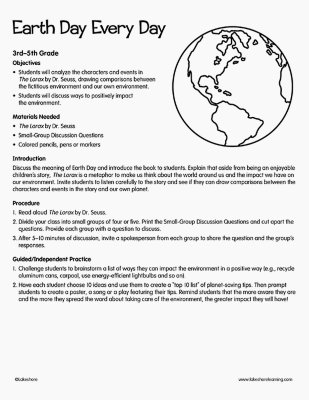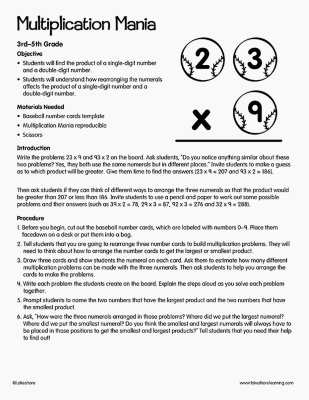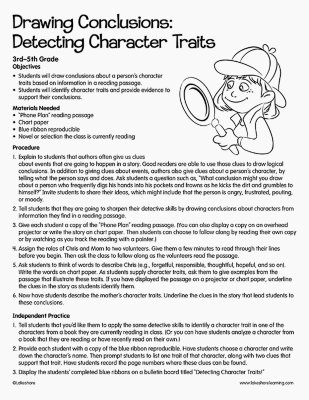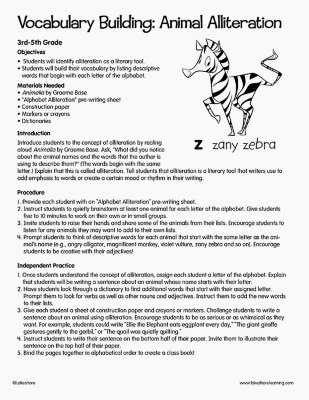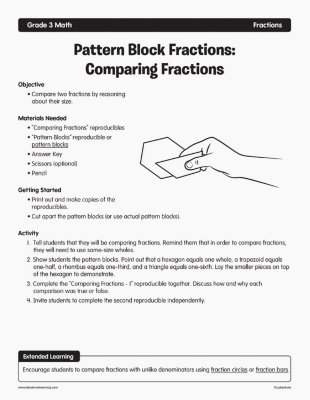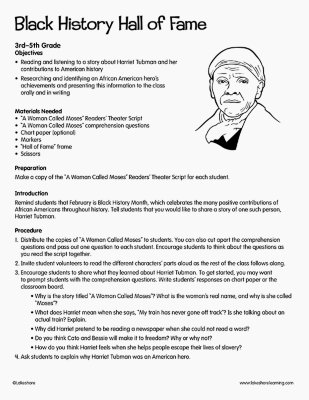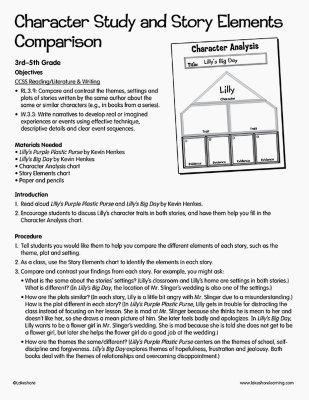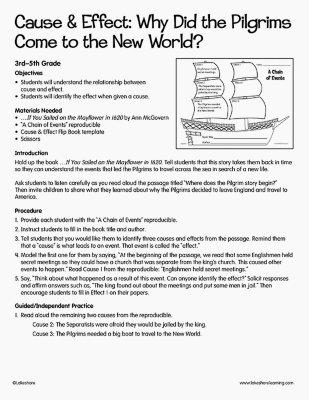Narrow by Grade
- Infant (0)
- Toddler (3)
- Preschool (0)
- Pre-K (12)
- Kindergarten (18)
- 1st (20)
- 2nd (14)
- 3rd (19)
- 4th (20)
- 5th (6)
- 6th & Up (0)
Grade 3rd
Narrow by Age
- 0-18m (0)
- 18-36m (0)
- 3 yrs. (0)
- 4 yrs. (0)
- 5 yrs. (0)
- 6 yrs. (0)
- 7 yrs. (0)
- 8 yrs. (19)
- 9 yrs. (12)
- 10 yrs. (3)
- 11 yrs. & Up (0)
Age
19 results for "nuts about"
Filters
Clear All
Read & Write About It
3rd Grade - 4th Grade
Objectives CCSS Writing W.3.2: Write informative/explanatory texts to examine a topic and convey ideas and information clearly. W.3.2a: Introduce a topic and group related information together; include illustrations when useful to aiding comprehension. W.3.2b: Develop the topic with facts, definitions, concrete details, quotations, or other information and examples related to the topic. W.3.2d: Provide a concluding statement or section related to the information or explanation presented. Materials Needed Jackie Robinson reading passage Jackie Robinson Fact Sheet graphic organizer Whiteboard, overhead projector, document camera or interactive whiteboard Informative passages and graphic organizers (“Chocolate Town,” “Praying Mantis” and “Why Can’t You Tickle Yourself?”) Fact cards and writing assignment prompts (“Scientists at Work,” “Natural U.S. Landmarks,” “The Olympic® Games” and “Going West”) Introduction Note: This lesson plan can be completed in more than one day. Explain to students that authors of informative/explanatory texts write to convey specific facts or ideas about a person, topic or event. State that you will read aloud an example of this type of writing using the Jackie Robinson passage. Have students read along with you. As a class, list the key pieces of information to determine the facts that the author wants the reader to know about the topic. Explain that deconstructing a passage in this way helps them become better writers. This process will assist them in thinking about how to use a list of facts to create an interesting paragraph or passage about a given topic.
View Lesson PlanAutumn Tree Sentence Building
3rd Grade - 4th Grade
Objectives Students will identify the subject and predicate of a sentence. Students will pair subjects with predicates to form sentences. Materials Needed Sentence parts reproducible Construction Paper - 9" x 12" or Fadeless Paper Rolls (brown, red, yellow and orange) Sentence strip Paper Pencils Preparation: Twist brown construction paper and staple it to a bulletin board to make a tree trunk and branches. Attach construction-paper leaves in red, yellow and orange to complete the autumn tree. Label the trunk “Subject” and the branches “Predicate.” Introduction Introduce the concept of subjects and predicates. Explain that the subject of the sentence tells who or what the sentence is about. The predicate of the sentence tells what happens. Write an example sentence on the sentence strip and hold it up for the class to see. For example, you could write, “The hungry horse ate all the hay in the barn.” Ask students, “Which part of this sentence is the subject? Who or what is the sentence about?” (The subject is the hungry horse.) Then ask, “Which part is the predicate? What did the horse do in the sentence?” (He ate all the hay in the barn.) Cut the sentence strip in two between the subject and predicate. Place the subject on the tree trunk and attach the predicate to one of the branches.
View Lesson PlanPumpkin Measurement
3rd Grade
Objectives Students will listen to a story about pumpkins and learn more about them. Students will learn and understand measurement vocabulary words. Students will estimate—and then measure—the weight, height, circumference, radius and diameter of a pumpkin. Materials Needed Pumpkins by Ken Robbins Small- to medium-sized pumpkins (one for each small group of three to four students and one medium pumpkin for the class) Pumpkins should vary in size as much as possible. Scale Sharp knife (for teacher or adult use only) Rulers String or yarn Pencils Pumpkin Measurement Record Sheet Introduction Read aloud Pumpkins by Ken Robbins. Hold up a medium-sized pumpkin and ask students to estimate, or guess, how much the pumpkin weighs. (Students’ estimates will probably vary widely.) Explain to students that having a starting point of knowledge before estimating will help estimates be more accurate. For example, if students know how much the pumpkin in your hands weighs, this knowledge will help them estimate the weight of smaller or larger pumpkins. Weigh your pumpkin on a scale and tell students the weight. Explain that you’ll be using this measurement in the next activity.
View Lesson PlanWriting a Persuasive Brochure
3rd Grade - 5th Grade
Objectives Using reference materials to research for their writing Introducing the topic or text they are writing about, stating an opinion and creating an organizational structure that lists reasons Providing reasons that support the opinion Reporting on a topic or text, telling a story, or recounting an experience in an organized manner, using appropriate facts and relevant, descriptive details to support main ideas or themes; speaking clearly at an understandable pace Materials Needed Sample tourist pamphlets for exotic vacation destinations (available from local travel agents or hotels) Reference materials Travel Brochure reproducible Crayons or markers Glue (optional) Scissors (optional) Introduction Ask students, “If you could visit anywhere in the world, where would you go? What would you do there?” Invite students to share their responses. Encourage them to talk about places they have never been but would like to see. Prompt students to point out their destinations on a map.
View Lesson PlanEveryday Learning Activities
3rd Grade
Book Journal Start a journal with your child in which you write letters back and forth to each other about the books you are reading. Ask questions about the characters or things you’ve learned from the books, or describe how the books remind you of other books you’ve read.
View Lesson PlanCompare & Contrast Countries
3rd Grade
Objectives
- Learn about different countries around the world.
- Compare and contrast two countries.
Literal vs. Nonliteral Meanings
3rd Grade - 4th Grade
Objective CCSS Language/Vocabulary Acquisition and Use: L.3.5.a, L.4.5.b Demonstrate understanding of word relationships and nuances in word meanings: a. Distinguish the literal and nonliteral meanings of words and phrases in context (e.g., take steps). Demonstrate understanding of figurative language, word relationships and nuances in word meanings: b. Recognize and explain the meaning of common idioms. Materials Needed Amelia Bedelia by Peggy Parish Chart paper and marker or chalkboard and chalk or document camera Illustrating Idioms page Wrap-Around Language Idiom cards and answer key Markers or Crayons Best-Buy Scissors Before You Begin Explain to students that words or phrases can have literal or nonliteral meanings. Tell them that a nonliteral meaning is when a phrase means something other than the exact words in it. Explain that authors sometimes use nonliteral meanings in their writing as a way to make a comparison or an exaggerated statement about something. For example, an author writing that someone is a “night owl” is really saying that this person is awake and active at night (nonliteral meaning) rather than stating that the person turns into an animal at night (literal meaning). Tell students that you are going to read the story Amelia Bedelia by Peggy Parish. Ask students to actively listen for the idioms, or nonliteral phrases, that are used in the story. Introduction Begin reading aloud to the class Amelia Bedelia by Peggy Parish. As you read, pause to point out one or two forms of figurative language (e.g., “change the towels” on p. 16 or “draw the drapes” on p. 25) that cause confusion for Amelia. Ask students to explain and describe what they really mean, as opposed to Amelia’s literal interpretation of the phrases. Before you continue with the story, ask students to pay special attention to some of the other forms of figurative language in the story as Amelia encounters them.
View Lesson PlanMenu Math
3rd Grade - 4th Grade
Objectives CCSS Math: Operations & Algebraic Thinking 3.OA.D.8: Solve two-step word problems using the four operations. Represent these problems using equations with a letter standing for the unknown quantity. Assess the reasonableness of answers using mental computation and estimation strategies including rounding. 4.OA.A.3: Solve multistep word problems posed with whole numbers and having whole-number answers using the four operations, including problems in which remainders must be
View Lesson PlanMy Awesome, Amazing, Very Good, Super-Great Day Story
3rd Grade - 4th Grade
Objectives Students will listen to, recall and interpret information from literature. Students will make connections to their personal experiences. Students will write a descriptive paragraph. Materials Needed Alexander and the Terrible, Horrible, No Good, Very Bad Day by Judith Viorst Graphic organizer Revising and Editing checklist Introduction Read aloud Alexander and the Terrible, Horrible, No Good, Very Bad Day to your class. After you read, ask students to recall the things that happened to Alexander that added to his terrible, horrible, no good, very bad day. Then ask students to think about what could have happened differently to turn Alexander’s day into an awesome, amazing, very good, super-great day. Invite volunteers to share their responses.
View Lesson PlanThe Sea and Me: A Measurement Lesson
3rd Grade
Objective Students will use measurement skills to compare the relative size of sea animals. Materials Needed Is a Blue Whale the Biggest Thing There Is? by Robert E. Wells Adding machine paper roll Tape measure 6 rocks (as paperweights) Butcher paper sheets (large enough for students to lie down on) “The Sea and Me” Record Sheet Rulers Pencils Scissors Preparation: Cut a strip of adding machine paper to match the average length of each sea animal below: Blue Whale: 94 ft. Orca: 32 ft. Bottlenose Dolphin: 12 ft. Label each strip with the name of the animal. (Do not write the length of the animal on the strip.) Introduction Tell students that they are going to learn about measurement and relative size. Then read Is a Blue Whale the Biggest Thing There Is? by Robert E. Wells. After you have finished the book, ask students to share examples of relative size that are given in the book (e.g., a blue whale is big compared to other animals but small compared to Mount Everest). Finally, tell students that they are going to compare the sizes of three sea animals. Then they will compare their own size to the three animals.
View Lesson PlanEarth Day Every Day
3rd Grade - 5th Grade
Objectives Students will analyze the characters and events in The Lorax by Dr. Seuss, drawing comparisons between the fictitious environment and our own environment. Students will discuss ways to positively impact the environment. Materials Needed The Lorax by Dr. Seuss Small-Group Discussion Questions Colored pencils, pens or markers Introduction Discuss the meaning of Earth Day, and introduce the book to students. Explain that aside from being an enjoyable children’s story, The Lorax is a metaphor to make us think about the world around us and the impact we have on our environment. Invite students to listen carefully to the story and see if they can draw comparisons between the characters and events in the story and our own planet.
View Lesson PlanMultiplication Mania
3rd Grade
Objectives Students will find the product of a single-digit number and a double-digit number. Students will understand how rearranging the numerals affects the product of a single-digit number and a double-digit number. Materials Needed Baseball number cards template Multiplication Mania reproducible Scissors Introduction Write the problems 23 x 9 and 93 x 2 on the board. Ask students, “Do you notice anything similar about these two problems? Yes, they both use the same numerals but in different places.” Invite students to make a guess as to which product will be greater. Give them time to find the answers (23 x 9 = 207 and 93 x 2 = 186). Then ask students if they can think of different ways to arrange the three numerals so that the product would be greater than 207 or less than 186. Invite students to use a pencil and paper to work out some possible problems and their answers (such as 39 x 2 = 78, 29 x 3 = 87, 92 x 3 = 276 and 32 x 9 = 288).
View Lesson PlanDrawing Conclusions: Detecting Character Traits
3rd Grade - 4th Grade
Objectives Students will draw conclusions about a person’s character traits based on information in a reading passage. Students will identify character traits and provide evidence to support their conclusions. Materials Needed “Phone Plan” reading passage Chart paper Blue ribbon reproducible Novel or selection the class is currently reading
View Lesson PlanVocabulary Building: Animal Alliteration
3rd Grade - 4th Grade
Objectives Students will identify alliteration as a literary tool. Students will build their vocabulary by listing descriptive words that begin with each letter of the alphabet. Materials Needed Animalia by Graeme Base “Alphabet Alliteration” pre-writing sheet Construction paper Markers or crayons Dictionaries Introduction Introduce students to the concept of alliteration by realing aloud Animalia by Graeme Base. Ask, “What did you notice about the animal names and the words that the author is using to describe them?” (The words begin with the same letter.) Explain that this is called alliteration. Tell students that alliteration is a literary tool that writers use to add emphasis to words or create a certain mood or rhythm in their writing.
View Lesson PlanPattern Block Fractions: Comparing Fractions
3rd Grade
Objective
- Compare two fractions by reasoning about their size.
Black History Hall of Fame
3rd Grade - 5th Grade
Objectives Reading and listening to a story about Harriet Tubman and her contributions to American history Researching and identifying an African American hero’s achievements and presenting this information to the class orally and in writing Materials Needed “A Woman Called Moses” Readers’ Theater Script “A Woman Called Moses” comprehension questions Chart paper (optional) Markers “Hall of Fame” frame Scissors Preparation Make a copy of the “A Woman Called Moses” Readers’ Theater Script for each student. Introduction Remind students that February is Black History Month, which celebrates the many positive contributions of African Americans throughout history. Tell students that you would like to share a story of one such person, Harriet Tubman.
View Lesson PlanCharacter Study and Story Elements Comparison
3rd Grade - 4th Grade
Objectives CCSS Reading/Literature & Writing RL.3.9: Compare and contrast the themes, settings and plots of stories written by the same author about the same or similar characters (e.g., in books from a series). W.3.3: Write narratives to develop real or imagined experiences or events using effective technique, descriptive details and clear event sequences. Materials Needed Lilly’s Purple Plastic Purse by Kevin Henkes Lilly’s Big Day by Kevin Henkes Character Analysis chart Story Elements chart Paper and pencils Introduction Read aloud Lilly’s Purple Plastic Purse and Lilly’s Big Day by Kevin Henkes. Encourage students to discuss Lilly’s character traits in both stories, and have them help you fill in the Character Analysis chart.
View Lesson PlanClose Reading and Text Features
3rd Grade - 4th Grade
Objectives CCSS Reading: Informational Text RI.3.7: Use information gained from illustrations (e.g., maps, photographs) and the words in a text to demonstrate understanding of the text (e.g., where, when, why, and how key events occur). RI.4.7: Interpret information presented visually, orally, or quantitatively (e.g., in charts, graphs, diagrams, time lines, animations, or interactive elements on Web pages) and explain how the information contributes to an understanding of the text in which it appears. Materials Needed “Three Cheers for Engineers!” reading passage Paper and pencils Introduction Provide students with a copy of the “Three Cheers for Engineers!” reading passage. Tell students, “Today we are going to read a passage titled, “Three Cheers for Engineers!” One practice of good readers is that they pay close attention to the text. As we read, I want you to think about the meaning of the text, the words that are used and other features on the page that are used to help interpret the text.”
View Lesson PlanCause & Effect: Why Did the Pilgrims Come to the New World?
3rd Grade
Objectives Students will understand the relationship between cause and effect. Students will identify the effect when given a cause. Materials Needed …If You Sailed on the Mayflower in 1620 by Ann McGovern “A Chain of Events” reproducible Cause & Effect Flip Book template Scissors Introduction Hold up the book …If You Sailed on the Mayflower in 1620. Tell students that this story takes them back in time so they can understand the events that led the Pilgrims to travel across the sea in search of a new life. Ask students to listen carefully as you read aloud the passage titled “Where does the Pilgrim story begin?” Then invite children to share what they learned about why the Pilgrims decided to leave England and travel to America.
View Lesson Plan